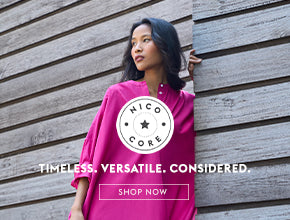India Modern
“This brand does not define you. But damn you look good in it.” Preeti Verma’s postscript-like message, imprinted on the tag of every one of her fashion label
Runaway Bicycle’s floaty, sorbet products, echoes the sort of sweet and sassy exchange that forms the heart of female friendships: “N’aww! Really? It’s not too tight?”
The young offshoot of Indian luxury giant Goodearth, Nicobar’s December newsletter exhorts subscribers to “Give us a cuddle” with a softly de-saturated grid of their cocoon-like winter silhouettes, alongside Maasai-inspired kulhars that evoke endless winter-sun- soaked chai sessions. It’s all you can do to not daintily sigh at your inbox.
A growing number of independent fashion labels like Runaway Bicycle and Nicobar have created a new niche of Indian designerwear – you may now enjoy an ethically-sourced, lovingly-crafted, whimsy-rich box dress for little more than a Zara price tag, and minus the snaking billing queue. Forming a kind of premium homegrown high street, these brands may just be the nicest iteration of “India Modern”, the Amazon.in- coined catchphrase for India-rooted fashion that holds up to global standards.
A sweeping glance at the line-up does throw up a design template: artisanal basics in roomy shapes, made from natural or traditional fabrics and dyes. “There’s a new pared-back, palate-cleansing aesthetic that has steadily emerged, almost as a reaction against the embellished, colour-soaked mainstay of Indian fashion,” said Aishwarya Subramanyam, editor of ELLE magazine.
In fact, so quickly have labels providing this sort of comfort-meets- conscience style multiplied, that the new wave may already be cooling into just another sartorial stereotype.
Stylist and consulting Fashion Director of Grazia magazine, Ekta Rajani, disagrees. According to her, the sameness is only proof of a design movement finding its feet.
“One sees homogeneity in design movements all over the world. We are at the very beginning of this one,” she said. “As designers explore this new code, some things may appear similar. Customers are adopting [the aesthetic] and commercial success is as important as design innovation. But that does not take away from their appeal if designed and presented well.”
When you are all using a similar design idiom, your narrative becomes important. So unlike their luxury counterparts, you won’t hear these labels emphasising sustainability, provenance, craft or national pride. Those are a given. Instead, they prefer to trade in – and differentiate themselves by – the stories of modern India they tell.
Raul Rai, CEO and co-founder of Nicobar, says their story is that good design isn’t just a novelty experience for special occasions – it should permeate the everyday. To that end, they want to “shrink your wardrobe, not expand it” with their simple, well-cut, largely neutral-coloured pieces that pair well with different styles and stay relevant for a long time. So you buy well, instead of lots.
“Our main principles are individuality and universality, however self-contradictory that sounds,” said Anand Ahuja, CEO and director of bhane., a brand of functional basics that would travel well in any world city. He believes if globalisation has taught us anything it is that we all want the same thing: to both, fit in and stand out. When bhane launched its US website late last year, it transplanted its signature streetstyle-inspired look books. The campaigns “New Delhi to New York” and “Bay to Bay” featured young, creative professionals from New Delhi, New York, Mumbai and San Francisco. “We wanted to showcase how even in different parts of the world, we are so similar in so many ways,” said Ahuja. Verma’s motivation for Runaway Bicycle is more micro. The collections, rife with natural cottons and khadis, are geared towards comfort and personal autonomy over everything else. “I want you to move freely in my clothes – sit unselfconsciously, in any way you like, or climb a tree if that’s what you want,” she said. “We develop our textiles based on how comfortable they can be, not just how beautiful.” Last year, Verma toyed with the idea of introducing silk, for instance, but changed her mind because it needs dry-cleaning, which would be cumbersome and cost-ineffective for the customer. “It immediately negated what we stand for.” Instead, Verma introduced
North East Indian eri silk threads in her weaves, achieving the desired sheen without the need for dry-cleaning. Stylists and ex-fashion- magazine colleagues Karuna Laungani and Gauri Verma’s startup Jodi uses only pure cotton sourced from South India and actually provides a graphic, body-conscious counterpoint to the category. They made the young Indian working woman – her body type, the colours she likes to wear and how she likes to be seen – their focal point. “I think we have hit a chord with women who are opinionated but not aggressively so,” said Gauri Verma. “They like being seen but not in an extravagant way.”
A large part of these labels’ appeal is how nimbly they contextualise their customers’ lives. A combination of social media, small operations and intimate retail formats, like targeted pop-ups and travelling trunk shows, lets them do this. But it also helps that they are mostly run by digitally and culturally adroit millennials for people like themselves, who understand that in a multicultural, transnational world, it is not kosher to be any one thing. Most of them reject the “fashion label” tag, in fact, preferring more ideological definitions like “design movement” or “culture brand”.
It is easy to be taken with Preeti Verma, for instance, a former creative director at an ad agency, who has no formal training in apparel design – or homeware design, into which she will branch next year. “I didn’t know how to make clothes, but I knew how to make a brand,” she said. From the packaging to the tags, to the product descriptions and the mood of the look books (she shoots them all herself and the models never wear make-up), Runaway Bicycle embodies a sweet guilelessness that is hard to replicate.
Another former ad art director Chondamma Cariappa’s handcrafted leather-and-handloom footwear label, The Sole Sisters, began as a blog in 2009 to document her love for shoes. By the time she launched her first collection in 2014, she already had a loyal community of footwear fanatics waiting to turn customers. Harnessing only
Instagram, Facebook and the occasional trunk show, she receives between 150 and 200 orders every month, as well as inquiries and subsequent contracts from international boutiques looking to stock her designs.
Rai says pop-ups in cultural hubs like the Kyoorius Design Yatra or Kochi Biennale are key to Nicobar’s expansion strategy, but it is their blog Nico Journal – edited and peopled by cool creative folk along with beautiful pictures and sharp prose – that gives them a definitive voice in the zeitgeist. “Through its content, Nicobar becomes that rare place on the web where shopping, culture, and mindfulness collide.”
Personal, one-on- one connection remains the cornerstone of the independent fashion label, however. Preeti Verma makes it a point to respond to all customer emails within the same day, Jodi’s parcels arrive in custom-print wrapping paper, “like presents”, often along with personal notes from its founders. Cariappa routinely discusses cats, recipes and travel with clientele and Rai has a WhatsApp group for daily updates from his Delhi, Mumbai and Bangalore store teams, which include the mandatory “customer delight” story.
But this presupposes smallness and therefore slow production and supply. The bigger the operation, the more streamlined and standardised it gets. This may mean the category of India Modern remains sort of diffuse and hyper-niche, with majority of shoppers still relying on the steady churn of mass brands. Most of the labels say they are okay with this scenario if it means they can mine deeply for a loyal customer base.
Competing with H&M and Zara or deep discount players like Myntra and Jabong, is not even on the radar. “Let’s put it this way,” said Rai, who plans to open five more stores before the end of next year (the company’s four-year expansion plan accomplished in half the time due to the overwhelming market response). “I went for the Coldplay concert . You know how many people [of the over 70,000 attending] I spotted wearing Nicobar? One.”
Story as it appeared in Scroll.in

















